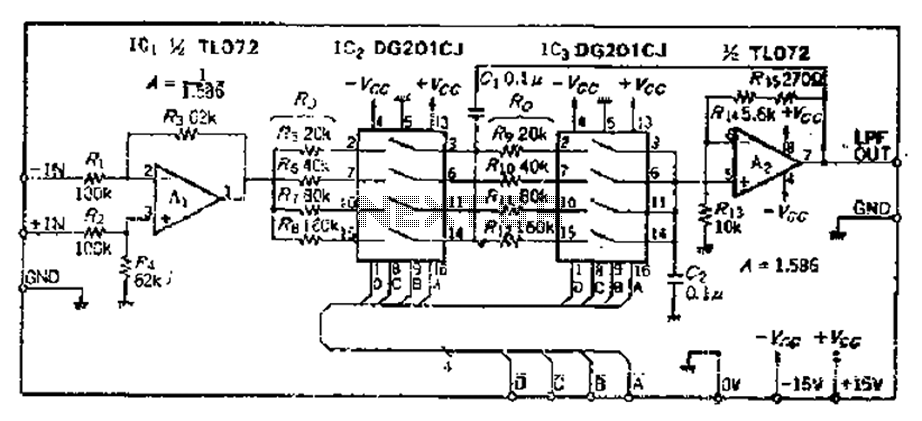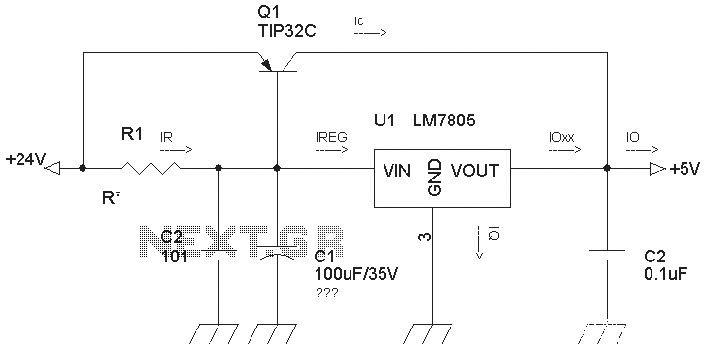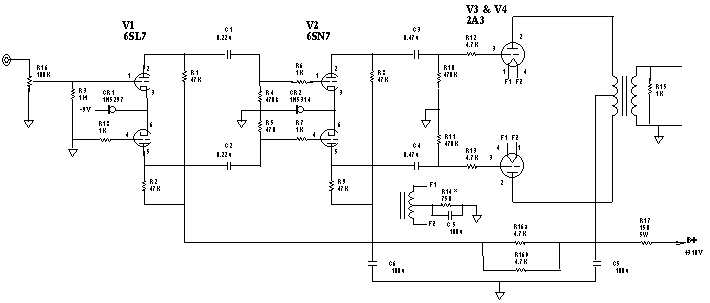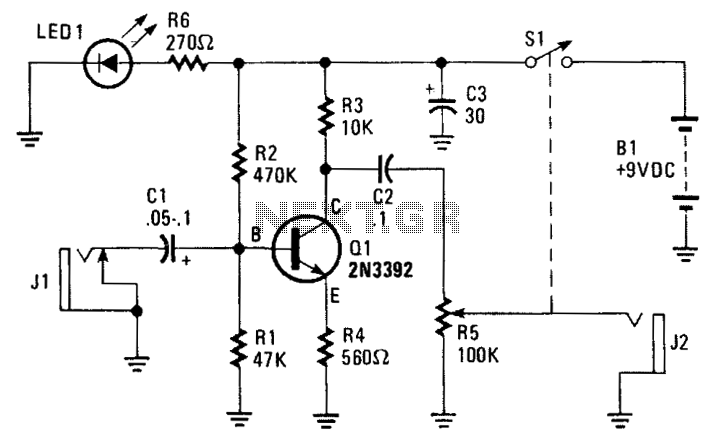
THREE FREQUENCY AUDIO OSCILLATOR
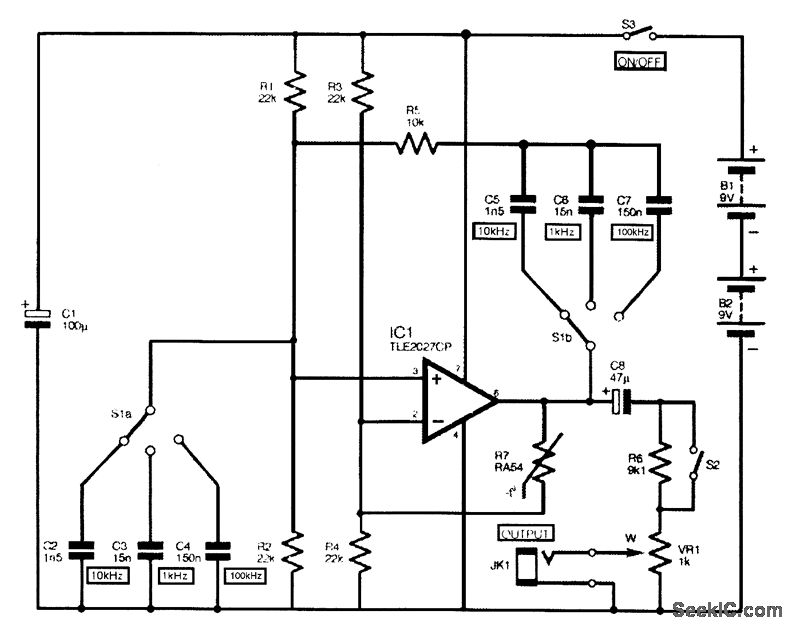
The complete circuit diagram for the audio sine-wave generator is presented. Resistors R1 and R2 provide biasing to the non-inverting (pin 3) input of IC1, and their parallel resistance constitutes one component of the Wien network. They correspond to R1 in Figure 1. The other resistor within the Wien network is R5. Three pairs of capacitors (C2 to C7) are switched to offer three distinct output frequencies. Resistors R3 and R4 provide biasing to the inverting (pin 2) input of IC1, with their parallel resistance also functioning as a component of the negative-feedback network. Thermistor R7 forms the additional part of the negative-feedback circuit. An RA53 thermistor is typically chosen for this application; however, an RA54 is utilized in this circuit due to its lower cost. Potentiometer VR1 serves as the variable-output attenuator. Engaging switch S2 introduces losses through resistor R6, resulting in a reduction of approximately 20 dB in output. A resistor value of 100 kΩ for R6 is recommended if a reduction of about 40 dB is desired.
The audio sine-wave generator circuit is designed to produce a stable sine wave output at various frequencies, making it suitable for audio testing and other applications requiring sine wave signals. The Wien bridge oscillator configuration is utilized, which is renowned for its ability to generate low-distortion sine waves.
In this circuit, resistors R1 and R2, along with capacitor pairs C2 to C7, establish the frequency of oscillation. The values of these components can be adjusted to achieve the desired output frequency. The configuration allows for the selection of different capacitor pairs, enabling three different frequency outputs, which can be easily switched depending on the application requirements.
The feedback mechanism is crucial for maintaining stable oscillations. Resistors R3 and R4, in conjunction with thermistor R7, form a negative-feedback loop that helps to regulate the amplitude of the output signal. The thermistor's resistance varies with temperature, which allows for automatic adjustment of gain, ensuring that the amplitude of the sine wave remains consistent even as conditions change.
Potentiometer VR1 offers the user control over the output level, allowing for fine adjustments to the amplitude of the sine wave signal. This feature is particularly useful in applications where precise signal levels are necessary.
Switch S2 serves as a means to introduce additional attenuation through resistor R6. This capability is beneficial for applications that require lower output levels without the need for additional external components. The choice of resistor value for R6 can significantly influence the degree of attenuation, with a 100 kΩ resistor providing a substantial reduction in output amplitude.
Overall, this audio sine-wave generator circuit is a versatile tool for generating high-quality sine wave signals, with features that allow for frequency selection, amplitude control, and stable operation across varying conditions.The full circuit diagram for the audio sine-wave generator is shown. Resistors R1 and R2 bias the noninverting (pin 3) input of IC1, and their parallel resistance forms one element of the Wien net-work. They are the equivalent of R1 in Fig. 1. The other resistor in the Wien network is R5. Three switched pairs of capacitors (C2 to C7) provide the u nit with its three different output frequencies. Resistors R3 and R4 bias the inverting (pin 2) input of IC1, and their parallel resistance also acts as one element of the negative-feedback network. Thermistor R7 is the other section of the negative-feedback circuit. An RA53 thermistor is the normal choice for this application, but because of its lower cost, an RA54 is used in this circuit.
Potentiometer VR1 is the variable-output attenuator. Opening switch S2 introduces losses through resistor R6 that reduce the output by about 20 dB. Use a value of 100 k © for R6 if a reduction by about 40 dB is preferred. 🔗 External reference
The audio sine-wave generator circuit is designed to produce a stable sine wave output at various frequencies, making it suitable for audio testing and other applications requiring sine wave signals. The Wien bridge oscillator configuration is utilized, which is renowned for its ability to generate low-distortion sine waves.
In this circuit, resistors R1 and R2, along with capacitor pairs C2 to C7, establish the frequency of oscillation. The values of these components can be adjusted to achieve the desired output frequency. The configuration allows for the selection of different capacitor pairs, enabling three different frequency outputs, which can be easily switched depending on the application requirements.
The feedback mechanism is crucial for maintaining stable oscillations. Resistors R3 and R4, in conjunction with thermistor R7, form a negative-feedback loop that helps to regulate the amplitude of the output signal. The thermistor's resistance varies with temperature, which allows for automatic adjustment of gain, ensuring that the amplitude of the sine wave remains consistent even as conditions change.
Potentiometer VR1 offers the user control over the output level, allowing for fine adjustments to the amplitude of the sine wave signal. This feature is particularly useful in applications where precise signal levels are necessary.
Switch S2 serves as a means to introduce additional attenuation through resistor R6. This capability is beneficial for applications that require lower output levels without the need for additional external components. The choice of resistor value for R6 can significantly influence the degree of attenuation, with a 100 kΩ resistor providing a substantial reduction in output amplitude.
Overall, this audio sine-wave generator circuit is a versatile tool for generating high-quality sine wave signals, with features that allow for frequency selection, amplitude control, and stable operation across varying conditions.The full circuit diagram for the audio sine-wave generator is shown. Resistors R1 and R2 bias the noninverting (pin 3) input of IC1, and their parallel resistance forms one element of the Wien net-work. They are the equivalent of R1 in Fig. 1. The other resistor in the Wien network is R5. Three switched pairs of capacitors (C2 to C7) provide the u nit with its three different output frequencies. Resistors R3 and R4 bias the inverting (pin 2) input of IC1, and their parallel resistance also acts as one element of the negative-feedback network. Thermistor R7 is the other section of the negative-feedback circuit. An RA53 thermistor is the normal choice for this application, but because of its lower cost, an RA54 is used in this circuit.
Potentiometer VR1 is the variable-output attenuator. Opening switch S2 introduces losses through resistor R6 that reduce the output by about 20 dB. Use a value of 100 k © for R6 if a reduction by about 40 dB is preferred. 🔗 External reference
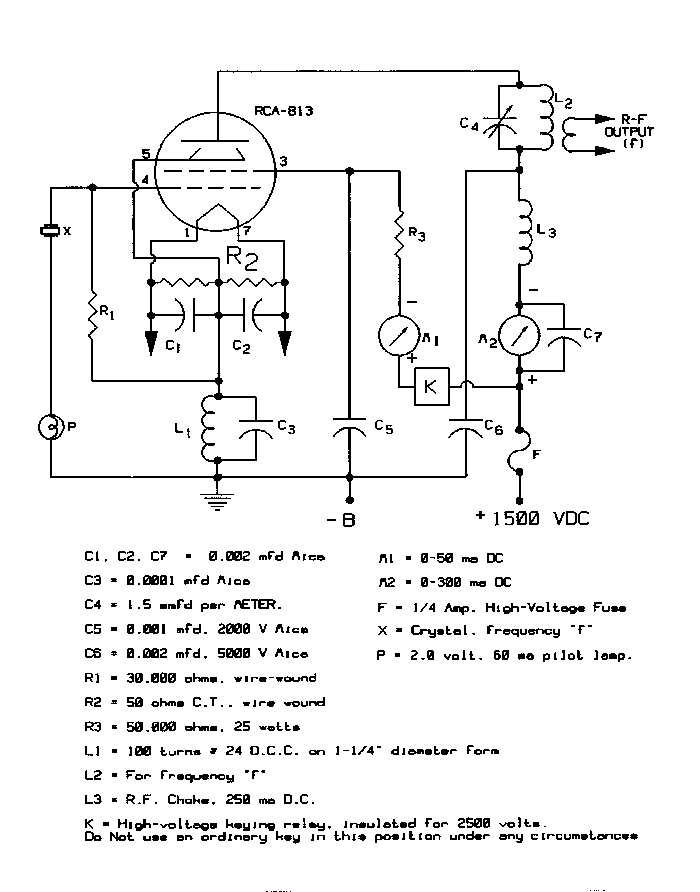
%2Bdecoder%2BCircuit%2Bschematic%2Busing%2BM8870.png)
